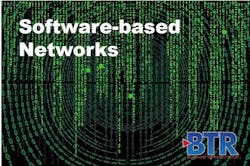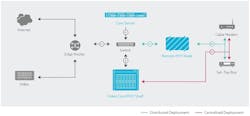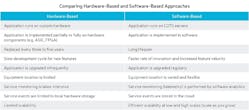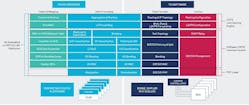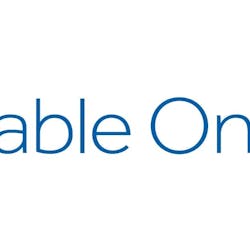Today’s cable operators face an unprecedented number of challenges. They must deliver an ever-increasing amount of data and video, including over-the-top (OTT), ultra high definition high dynamic range (UHD HDR), and data-intensive applications such as virtual reality and the Internet of Things (IoT), to subscribers. There’s more competition than ever from high-speed data providers and a growing demand for higher bandwidth and new value-added services.
The equipment needed to process and deliver these services is expensive and takes up a lot of space in the headend. Traditional solutions for cable access infrastructure — specifically the CMTS, edgeQAM and Converged Cable Access Platform (CCAP) — are purpose-built systems and by necessity have been hardware-based. Yet, the emergence of the CableLabs Remote PHY standard enabled the separation of the hardware-bound physical layer and RF components from the software-suitable higher layers, paving the way for the introduction of new software-based cable access technologies. This article will examine the challenges operators face with using traditional cable access network hardware and the benefits of a software-based approach, including increased flexibility, scalability and shorter development cycles.
Key Drawbacks of Traditional Cable Access Solutions
Because of the physical-layer characteristics of the cable architecture, cable-specific platforms have been developed for the delivery of data, video and voice services. Through the years, the packet processing and networking layers in the cable network, including the uppermost layers where cable-specific applications such as PacketCable and DOCSIS Set-top Gateway are processed, also have unique requirements. Historically, whenever the industry updated or created new cable access standards, purpose-built hardware platforms were designed to support these standards. Typically, the only way to deliver more advanced services and features to subscribers, as well as increased capacity, was to continue to develop hardware-based platforms.
Hardware-based access technologies are not ideal for a number of reasons: they lengthen development cycles, inhibit the vendor ecosystem and limit capacity and scalability. What’s more, flexibility is limited as hardware-based CMTS implementations are generally optimized to meet anticipated business objectives rather than being adaptable to unforeseen requirements. Hardware-based CMTS also comes with high operational expenses. In addition to high power costs, operators need to consider the regularly occurring cost of refreshing hardware, both in terms of labor and capital cost of the equipment. These costs can be greatly reduced with software running on commercial off-the-shelf (COTS) servers.
The Benefits of a Software-Based Cable Access Solution are Plentiful
By disaggregating CCAP functionality with a software-based approach, cable operators can mitigate many of the challenges associated with traditional hardware architectures and benefit from a more flexible and scalable deployment model (Figure 1).
Figure 1. A software-based CCAP architecture, showing both distributed and centralized deployment options.
A software-based approach offers much shorter and cost-effective development cycles in comparison with hardware-based technologies using application-specific integrated circuits (ASICs) and field-programmable gate arrays (FPGAs), as well as the option to take advantage of open-source or third-party software when available. Given that some of the newly proposed features will be available for earlier proof-of-concept implementation, the time span between standardization and multi-vendor interoperability can be reduced as well.
There are aspects of the access network that remain dependent on physical layer development, such as RF, that still require hardware and can’t be implemented in software. But, where feasible, a software-based approach enables operators to enjoy faster responsiveness for defect resolution, much higher feature velocity and a faster rate of innovation (see Table).
Moreover, a software-based and disaggregated cable access approach, which operates partially on COTS servers, provides a whole new dimension of scalability. Operators can start with a single 1 rack unit (RU) server and add new capabilities with software upgrades and more capacity in 1RU increments as business requirements dictate. By contrast, a hardware-based cable access approach takes up much more real estate and requires a much higher initial investment, especially for small-scale deployments. It also won’t scale effectively when the operator requires more capacity. When a chassis reaches its capacity limits, operators either need to install another chassis or replace the chassis with a denser version.
In today’s rapidly changing world, flexibility is important. A software-based and disaggregated cable access solution enables operators to expand features and services quickly. Moreover, it gives operators the potential opportunity to run multiple applications on a single server or across a cluster of servers. Distribution of software functions is not restricted to a single box or location. Cable operators can flexibly distribute software functions in the most cost-effective and operationally efficient manner, with the promise of using spare CPU resources for different applications.
Additional benefits of software-based cable access solutions include faster industry standardization cycles, richer vendor innovation, a more robust and competitive vendor ecosystem and increased scalability for meeting competitive capacity speeds. Investments are continuously being made to Intel compute platforms and their associated components, including network interface cards (NICs), facilitating cable operators’ move to a software-based and network functions virtualization (NFV) model.
When evaluating total cost of ownership (TCO) of a cable access solution, operators need to know how quickly a product or service can be monetized, as well as its responsiveness to operator requirements. The penalty for getting the design or implementation wrong in a hardware-based approach is dramatically higher than in software.
Software running on general-purpose Intel CPUs can be put on faster platforms as they become available. The software does not need to be customized or refactored for custom hardware. This distinction results in faster time-to-market and more frequent product releases with increased performance and scale. Over time, this characteristic also reduces the level of investment required and increases the cost-effectiveness of a software-based approach.
How to Make a Seamless Migration from Hardware to Software
Software-based cable access solutions offer a lot of promise and potential, and operators easily migrate to the new architecture in a series of steps. The first step involves supporting legacy services with operational familiarity in today’s centralized deployment architecture, including MPEG video delivery, out-of-band (OOB) signaling systems for MPEG video delivery and leakage detection. An end-to-end solution may not only include the CMTS core, but also video engine and OOB engine devices. With a software-based cable access architecture, the transport between cores/engines and PHY devices is Ethernet and standards based. As legacy services diminish, the need for video and OOB engine devices is reduced, with the software-based CMTS core eventually feeding all data, voice and video services over IP.
Software-based solutions should co-exist with existing hardware-based systems. This will enable operators to take advantage of immediate power and space savings, as well as capacity headroom. This type of hybrid approach involves running a software-based CMTS core on COTS Intel servers and a PHY shelf, which can be installed in an existing headend or hub (Figure 2).
Figure 2. CMTS functionality that can be virtualized in a software-based implementation.
The next step in the migration path is to push the PHY devices out of the headend and hub and move them further out in the network. Remote PHY delivers additional power and space savings. Relying on a distributed access architecture that leverages the benefits of digital fiber over analog, operators can support longer distances, more wavelengths and better cost efficiencies.
Today’s hardware-based cable access implementations have separate devices for each of the legacy services, but transport of the services is over RF and analog optics, preventing the ultimate convergence of all services over IP. Coupling a software-based approach with a Remote PHY architecture enables operators to fully transition to digital and IP.
A cluster of 1RU servers can serve many distributed Remote PHY nodes, and the servers can be further centralized into a data center. Eventually, the data-center-located servers can evolve to elastically support other applications beyond the CMTS application and can dynamically allocate CPU resources based on actual use, providing significant efficiencies and improving network flexibility.
Using a software-based cable access approach, operators also can transition from traditional CLI- and SNMP-based configuration and management to a software-defined networking (SDN) based approach to optimize the orchestration of services.
Conclusion
Numerous cable operators around the world have successfully deployed a software-based cable access solution in a variety of deployment architectures, migrating from hardware-based products to realize improved functionality, agility and scalability. The benefits of a software-based architecture running on COTS Intel servers are clear compared with hardware-based systems, which are expensive, purpose built and capacity limited.
By deploying COTS equipment and a software-based, disaggregated cable access solution, operators have virtually unlimited potential in terms of applications, location and capacity. Whether cable operators choose to deploy software either in a centralized or distributed architecture, they can drastically improve scalability and agility, while reducing opex and capex.
Asaf Matatyaou is vice president, solutions and product management, within the Cable Access Business at Harmonic.
